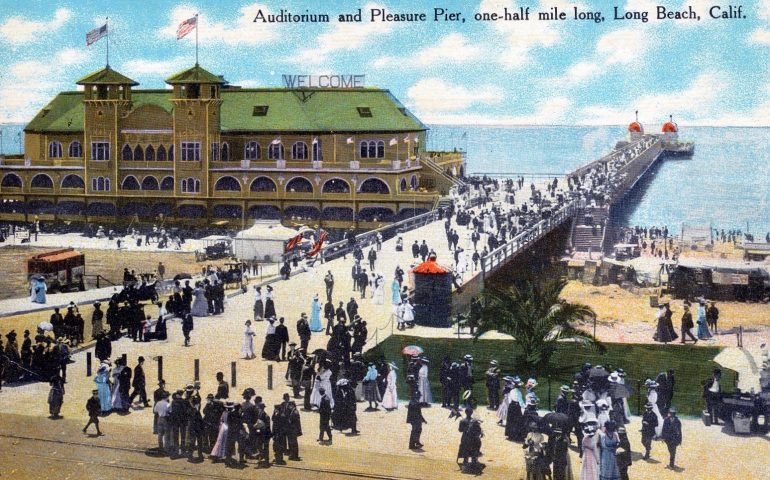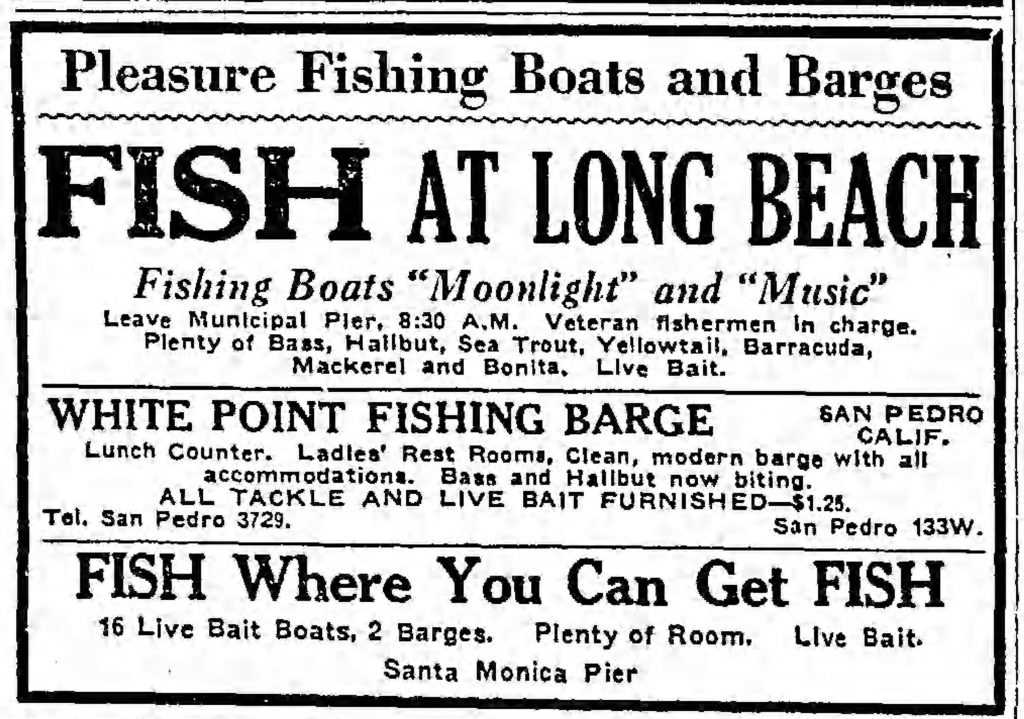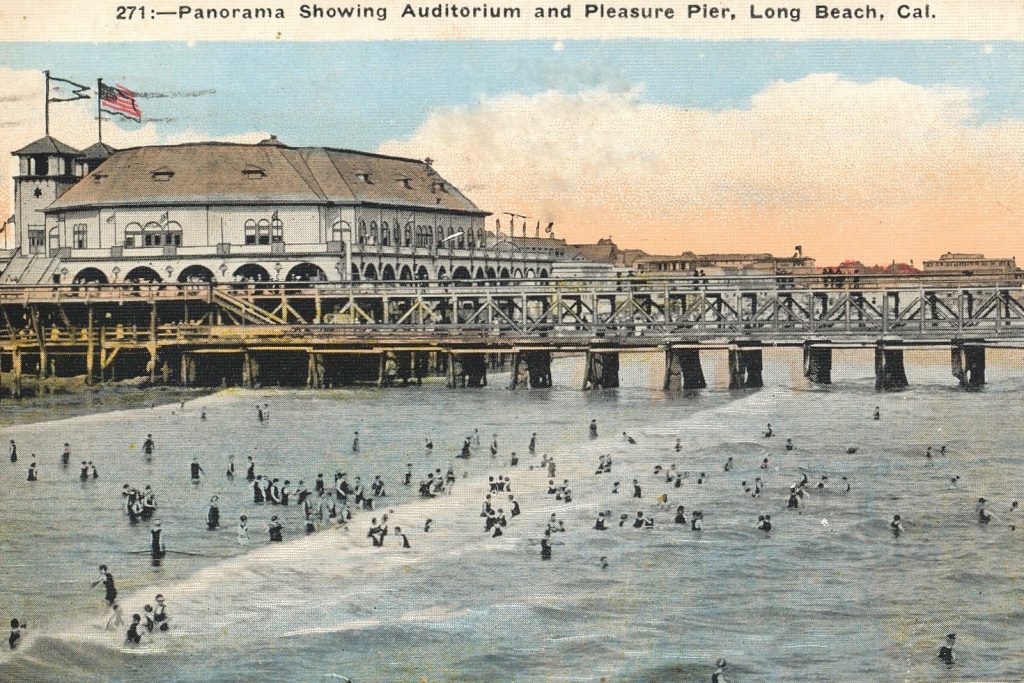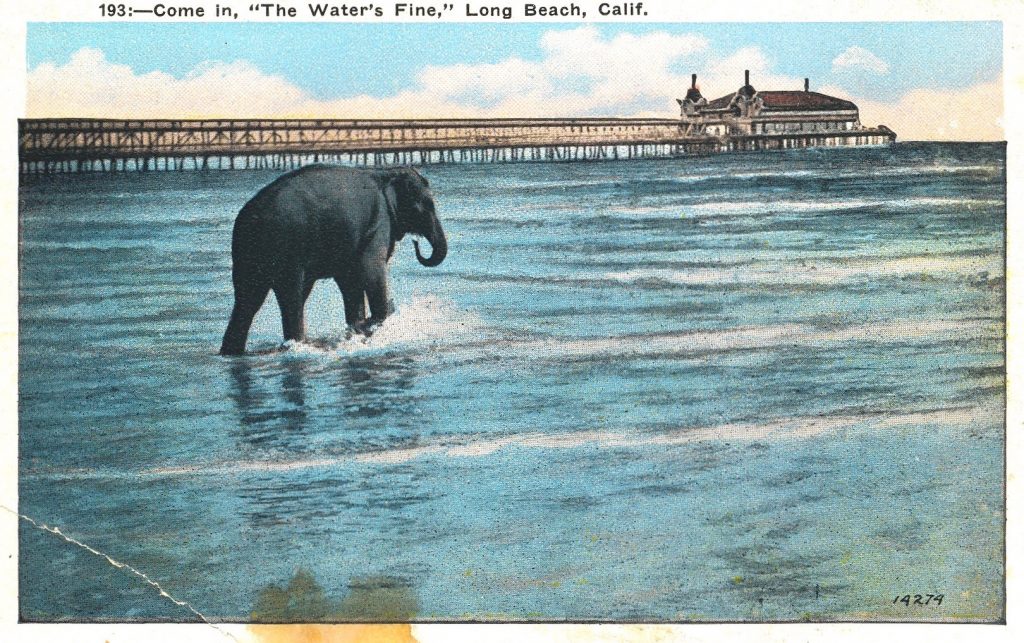Mackerel, herring, pompano, bass, croakers and sea trout are being caught from the end of the municipal pier. —Los Angeles Times, July 21, 1916
As usual there was a constant need for upkeep and repair to the pier. In April 1918, it was announced that more than 50,000 feet of lumber would be used to repair the upper deck approach to the pier, which would be closed for ten days. The lower deck was to receive 40,000 feet of flooring with new joists and girders installed for safety reasons. In September, high tides and heavy ground swells, believed to have been caused by an underwater earthquake, ripped the flooring from the girders of the lower deck, tore loose pilings, and carried away both boat landings. Damage was estimated at $10,000.
Huge Stingrays Caught — Visitors on the end of the Pine Avenue pleasure pier were treated to the sight of two of the most unusual deep-sea monstrosities ever drawn out of the Pacific at this port today. Albert Jewell, night man in charge of the municipal fish market, set out his lines as usual last night for black sea bass and sharks. When he pulled them in this morning he brought to gaff what are believed to be two of the largest stingrays ever captured in the Southland. The ordinary weight of a stingray is five pounds, but these tipped the scales at fifty-nine and seventy-five pounds respectively. Large crowds gathered during the day to view the big sea denizens. The sawtooth bones that makes the ray a most dangerous creature were more than five inches long on the big fish, while the average “business end” of these hostile salt water inhabitants is less than an inch. The two stingrays put up a game fight and it was only after an hour’s struggle and manipulation that they could be hauled to the surface. Even after being gaffed they lashed out viciously with their barbed tails. —Los Angeles Times, May 24, 1918
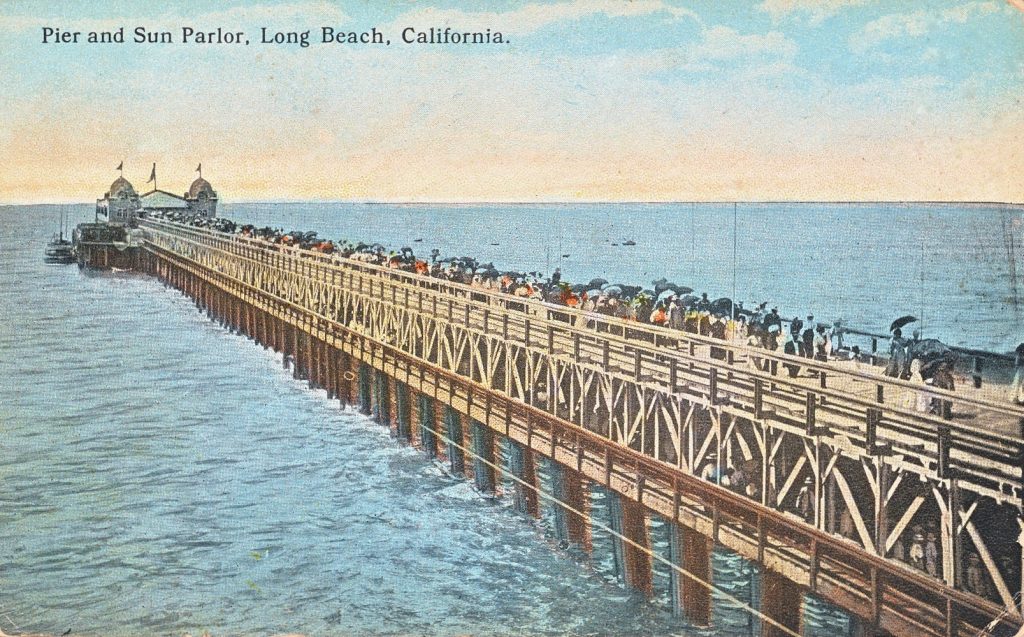
June of 1920 saw additional damage to the pier as high tides and heavy ground swells brought damage to the pier. The boat landing on the pier’s west side was carried away. A month later, on July 11, the same oceanic conditions tore out 30 pilings from the pier. An alarming report on September 14, 1921, said that “the Pine Avenue Pier is condemned.” However, it actually lasted for another decade.
A final ingredient to the Sportfishing scene at the pier was the introduction of fishing barges in the ‘20s. Barges included the James McKenna (1925 to postwar), Blue Sea (1928) and the Pastime (1929). The ‘30s, perhaps the heyday of barge fishing, saw several additional barges. The Shamrock and Bounty were available most of the decade while the Melrose operated for a few mid-‘30 years in Long Beach waters before moving down to San Clemente. The Samar operated 1937-38; it would be converted to a floating machine shop in WWII.
Nevertheless, fishing from the pier itself continued to be the main activity for most since it was free.
Fisherman Hooks Body — Long Beach, Aug. 17.—Fishing off the Pine Avenue pier here last night, William Richie hooked what he thought would be a record catch. Just before his line broke he caught sight of a human body. Today police recovered the body of Tony Toodoroff, Bulgarian. Toodoroff was drowned August 8 while bathing in the surf. —Santa Ana Register, August 17, 1921
Anglers Enjoy Run of Bonito at Long Beach — Long Beach, Oct.19.—Pine Avenue pier and particularly its outermost end, is a busy place these days and a late coming nimrod with his long bamboo pole or handline finds it difficult to find a place to sit along the string pieces. For bonito, that succulent denizen of the blue Pacific, has suddenly found the waters adjacent to the pier a most desirable place to stick around with the result that catches of bonito around the end of the pier the last few days have broken all previous records.
A large school of the fish have taken up their quarters around the pier and the inroads of fishermen in their ranks have been noticeable to date, neither have the fish been forced to other grounds. Several of the more lucky nimrods have filled bushel baskets and boxes with the blue and black and silver beauties. —Los Angeles Times, October 20, 1926
In 1929 a new report stated that ground breaking for the W. L. Poterfield building marks the beginning of the end for the pier and then, in April 1930, damage from huge breakers caused an estimated $100,000 damage to the pier and breakwater.
A new chapter in the story of the downtown shoreline and piers occurred on July 25, 1931 when the Rainbow Pier was officially opened just to the south and adjacent to the Pine Avenue Pier. The Rainbow Pier would now become the main pier while the Pine Avenue Pier would survive for a few more years with diminished duties.
In 1933, what remained of the Pine Avenue Pier saw extensive renovation. The shore end of the pier was removed and a link connected it with the Rainbow Pier. The pier was resurfaced, new pilings were installed, the service men’s clubhouse at the end of the pier was remodeled, and two boat landings, one for Navy officers and the other for fishing boats were improved. The now shortened pier became a spur that connected out from the seaward end of the Rainbow Pier.
By 1934, the short, 150-foot long pier was being used for a lifeguard station—and the end was near. On September 5, “freak” 35 to 40-foot high combers pounded the pier and caused it to collapse. Newspapers reported that “life guards worked frantically to remove equipment and escaped just as the wooden structure collapsed.” The San Mateo Times said the giant breakers reduced the pier to “kindling wood” while the Santa Cruz Sentinel reported that wood “was tossed like splintered toothpicks upon the beach.” The adjacent Rainbow Pier saw a 25-foot gap torn out by the huge waves but mostly withstood the storm. The life of the Pine Avenue Pier #2 was at an end and all that remained were memories. It was gone but not forgotten.
